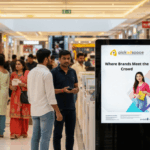Digital signage has emerged as one of the most powerful tools in contemporary marketing, offering a dynamic stage for brands to captivate audiences in an instant. Walk into a trendy coffee shop, a busy clinic, or even a corporate lobby and you’ll likely see sleek, high-resolution screens delivering ads, announcements, or interactive content. Far from the static posters of the past, these vibrant displays breathe life into brand messages and forge deeper connections with people in real time. In an age where consumers are bombarded with information, digital signage stands out by combining eye-catching visuals with flexible content that can be updated at a moment’s notice.
There’s a sense of excitement that accompanies digital signage installations. Marketers and venue owners alike anticipate the powerful storytelling potential they unlock. A local bakery, for example, can showcase mouthwatering pastries in vivid detail, cycling through new specials or seasonal recipes to keep regulars intrigued. Meanwhile, a tech company can highlight cutting-edge products and real-time testimonials, using motion graphics to capture the hustle and bustle of an airport corridor. By placing these signs strategically, businesses ensure they engage consumers when and where the impact is strongest.
Moving Beyond Traditional Advertising
Traditional methods—such as flyers, posters, and billboards—still have their place, but they often lack the flexibility and immediacy that digital signage offers. Once a poster has been printed, any change in messaging or visuals requires a complete reprint. This not only costs time and money but can also lead to missed opportunities if a promotion needs to shift quickly. Digital signage solves this by allowing content updates with a few clicks, turning static campaigns into dynamic journeys that adapt to the current moment.
Rather than splashing a single message across a large space, digital screens can rotate through multiple campaigns, each with its own unique design and call-to-action. This rotation keeps the content fresh while maximizing the advertisement’s potential to speak to different audience segments. For instance, during lunchtime, a quick-service restaurant might display a rotating menu of appetizing items; by evening, the screens could automatically switch to promotions for dinner combos or dessert offerings.
Brand Building That Resonates
Perhaps the biggest draw of digital signage lies in its power to reinforce brand identity in a fast-paced world. People are visual creatures, and compelling imagery plus bold typography can create instant brand recall. Because digital signage allows for animations, transitions, and even interactive elements, companies have countless ways to imprint their brand essence into the minds of viewers. It’s not just about showing an ad; it’s about crafting a narrative—be it one of innovation, warmth, luxury, or community.
Consider a home décor brand that showcases a living room transformation on a high-definition screen. Over the course of a minute, viewers see a drab space evolve into a stylish sanctuary, all thanks to the brand’s furniture and accessories. Such a story lingers far longer than a static photo, embedding a sense of possibility and excitement in the viewer’s mind. When done effectively, digital signage campaigns convert casual onlookers into loyal brand enthusiasts, triggering conversations and word-of-mouth.
The Importance of Engagement
One reason digital signage continues to grow in popularity is the unparalleled opportunity for real-time engagement. Interactive touchscreens, QR codes, and app integrations encourage viewers to do more than passively observe. They can tap through product lines, access promotional codes, or participate in short quizzes that highlight brand features. This active involvement boosts dwell time (how long someone pays attention to a screen) and ensures the brand’s message is truly absorbed.
Even non-interactive digital signage benefits from the ability to showcase diverse content. Companies can feature everything from short videos and testimonials to countdowns for upcoming events. By changing the material regularly, viewers remain curious about what might appear next, leading them to spend a bit more time in front of the screen. Those extra seconds can make all the difference in sparking a purchase or an inquiry.
Thriving in Competitive Spaces
In crowded markets, standing out can be a challenge. Digital signage provides a distinctive edge by allowing brands to tailor messages for specific audiences at specific times. A clothing store might display tropical vacation wear during the cold winter months to inspire dreams of escape, while a sportswear brand could highlight workout apparel during the early morning or after-work rush, when people are more likely to hit the gym. This targeted approach ensures messages resonate in the right moment—boosting conversions and brand sentiment.
Moreover, digital signage can be part of a multi-channel strategy. A brand’s social media feeds might sync with the display to show real-time posts or customer shout-outs, bridging the gap between online and offline engagement. This holistic approach not only keeps the content dynamic but also prompts viewers to follow the brand’s online platforms, creating a seamless pipeline for future marketing touchpoints.
Balancing Creativity with Analytics
Behind the scenes, digital signage can be paired with analytics tools that measure performance in granular detail. For instance, sensors might record how many people glance at the screen, how long they linger, and even whether they appear engaged. This data helps advertisers refine their messaging. If one piece of creative leads to more dwell time than another, marketers can optimize future content to match that winning formula. It’s an ongoing cycle of refinement that’s difficult to achieve with traditional print advertising.
This analytical depth allows businesses to see a clearer return on investment (ROI). Because content can be deployed quickly and measured effectively, brands can experiment with short campaigns to gauge consumer response. If a particular tagline falls flat, it can be replaced within hours. If a limited-time offer catches fire, it can be extended to sustain the momentum. The end result is a more efficient use of marketing dollars and a stronger overall brand presence.
Inspiring the Future of Brand Communication
As technology continues to evolve, we can expect digital signage to become even more immersive. Innovations like augmented reality (AR), facial recognition (for demographic insights), and gesture-based interactions are already making headway. These features can transform what might otherwise be a simple advertisement into a mini-experience. Imagine walking past a digital display that projects a virtual wardrobe around you, letting you “try on” outfits without ever stepping into a fitting room.
Despite all the technological bells and whistles, the heart of digital signage remains the same: to connect people with brands in a meaningful way. The immediacy of changing content, the potential for real-time engagement, and the impact of eye-catching visuals converge to create an advertising channel that feels fresh, relevant, and indispensable in our fast-paced world.
From the smallest mom-and-pop store to the largest multinational corporation, digital signage presents an accessible and efficient avenue for brand-building. It meets consumers where they are, whether that’s in a cozy café or a glossy shopping center, and delivers messages that linger long after they’ve stepped away from the screen. When done thoughtfully and creatively, digital signage is not just an investment in technology but an investment in brand relationships—those critical bonds that keep customers coming back for more.
In an era that prizes authenticity and immediacy, digital signage offers an exciting bridge between commerce and conversation. Brands get to tell stories in motion; consumers receive informative, relevant content; and venue owners can tap into lucrative revenue streams by hosting these dynamic displays. It’s a synergy that’s hard to ignore. The digital signage revolution is here, and it promises a future where ads don’t just inform us—they entertain, inspire, and invite us to be part of something bigger.


